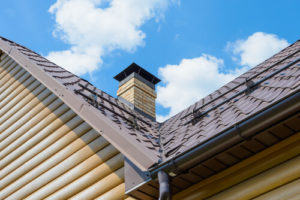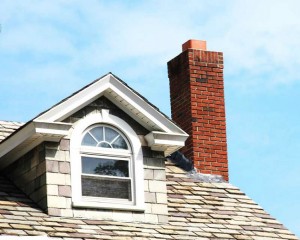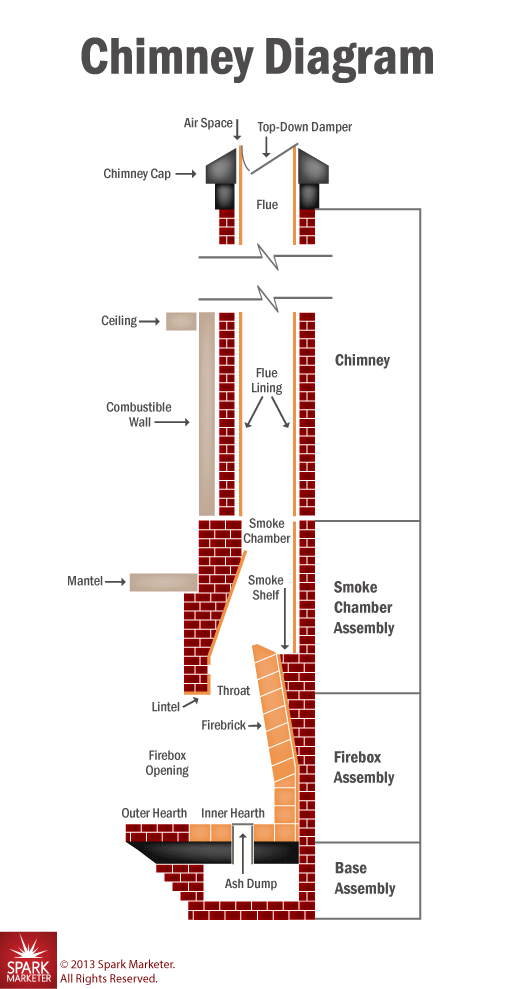Chimney Services » chimney damper
Our Company Blog
by Mike O'Mara | Mar 12, 2019 | Chimney Dampers
Are the temperatures inside of your home not staying where you want them to? Here in the San Diego area, we experience some pretty hot days, so getting everything you need from your air conditioner is an essential part of staying cool and comfortable. Unfortunately for those with a chimney in their home, air can easily slip out through the flue. Not only does this brew frustration for people inside, but it also causes your energy bills to skyrocket. One simple solution might be to have a top-sealing damper installed. Learn more about these below, then count on our team to help you out every step of the way.
The Function Of A Damper
So, what is the main purpose of a damper? Well, they were designed to keep outside air out and indoor air in when your fireplace is not in use. On the flip side, they can be opened once you light a fire to ensure smoke and other fumes safely escape outside. All in all, they ensure you get ultimate comfort, whether you decide to put your fireplace to use or not.
Most older fireplace dampers are located in the throat of the chimney. These have been effective enough for homeowners in the past, but now there’s a better option – a top-sealing damper.
Top-sealing dampers are positioned at the top of your chimney, rather than the throat, and instead of a metal-on-brick seal, they come equipped with a rubber gasket that securely closes up the flue. This ensures no air goes in and no air comes out. While a throat damper can do an effective job, there is simply no comparison to this superior alternative.
Along with this, throat dampers are known to rust and corrode, which can trigger further damage for your system, and it often isn’t worth fixing it or replacing it with a similar model. If your throat damper is showing signs of wear, it may be time to consider upgrading to a top-sealing design.
Stop Wasting Money
A top-sealing damper will close things up tightly, so you don’t have to stress about wasting energy every month and losing money. Stop trying to cool your home to no avail, and invest in a more efficient damper today. It is a choice you’ll be happy you made when you get your monthly bills in the mail!
Trust In Us
If you are ready to get started, trust in the team here at Weststar Chimney Sweeps. We can do a thorough inspection and ascertain whether or not your damper is the cause of your higher energy bills. If so, we have the skills, experience, and certifications to get you the results you deserve.
Give us a call today, and we can set up an appointment at a time that works well for you. Our team is excited to help you out soon!
by Mike O'Mara | Jul 3, 2017 | Damper
Have you been having issues with your throat damper? You are not alone! These devices have worked well in the past. However, there is a new option available that homeowners seem to love. We don’t blame them! If you need a new damper, consider investing in a top-sealing damper for your chimney.
If you’re wondering just what a top-sealing damper is, let us explain. This device sits at the top of your chimney, rather than the bottom. It has a rubber gasket so that a tight seal is formed, and it is controlled by a lever that is inside of your fireplace.
Saving You Energy
There are a lot of reasons why top-sealing dampers tend to function better than throat dampers. One of the biggest is their ability to seal your home a lot better, saving you lots of money on heating and cooling bills.
With throat dampers, any outside air gets sucked down your chimney, then can easily seep in through cracks and any possible holes. That makes keeping things cool hard to do… and watch out for any cold, nasty weather because things will get chilly fast!
Worried about the A/C escaping throughout the year? Worry no longer! Homeowners that invest in a top-sealing damper see significant drops in their monthly bills, and we want you to get all the savings that you can. Consider these products so that the warm, humid air stays out of your chimney altogether!
by Mike O'Mara | Feb 8, 2017 | Damper
Your fireplace damper is a vital piece in your chimney’s construction. It ensures proper ventilation while your fire is running, and keeps cold air from entering your home. Unfortunately, these devices can break down and there a number of reasons why it may not be working efficiently.
If you notice drafting and air flow issues in your fireplace, keep reading to educate yourself on the more typical damper problems that homeowners typically face. Call in a certified chimney expert to check things over and perform any necessary repairs that may be needed.
Watch Out For Build-Up
One of the more common issues that people face is built-up soot and debris blocking their damper. This would keep your damper from opening and closing properly and may prevent it from opening at all! If your damper can’t open, smoke will back up into your home, exposing you and loved ones to harmful toxins. Excess smoke backing up into your living room means something is wrong… if you think your damper needs some cleaning, contact us right away.
Another issue may have to do with your damper valve. If this is dirty, it will not function appropriately and your damper will not be able to do its job effectively. Let us check things over and we can set you up right.
Broken Damper
Another possibility is that your damper is broken. In this case, we could help you pick out the appropriate damper for your specific fireplace. We would also ensure that it is installed properly. Improper installation only leads to bigger and more costly issues down the line and choosing the right size and style for your needs is vital in helping the entire appliance run well, as a whole.
Depend On Us
The staff at Weststar Chimney Sweeps are trained and certified to perform a wide range of repairs. We can also clean and inspect your chimney, so you can safely run it all year round. If you are having ventilation issues, let us come take a look at your damper. We can make any necessary repairs or adjustments, as well as clean the chimney with appropriate tools and chemicals.
Our sweeps update their certifications with the CSIA on a regular basis, so we always remain up-to-date on any new advancements or changes in regulations. We pride ourselves on providing the best customer service around, which is why countless homeowners turn to us for any and all of their chimney or fireplace related needs.
Why put it off any longer? Give us a call now, so you can rest easy and enjoy your fireplace to the fullest. We look forward to making your home great!
by Mike O'Mara | Apr 29, 2015 | Chimney Maintenance
Can you identify the major components of your masonry chimney? If you cannot, you are not alone. Many homeowners have very little knowledge about their fireplace and chimney systems. When you do not know the names of certain parts or what exactly each part is supposed to do, it can be difficult to describe a chimney problem you could be experiencing. Knowing the details of each component of the anatomy of your chimney can help you discuss your issue with chimney professionals, like our staff at Weststar Chimney Sweeps. As part of our responsibilities as Chimney Safety Institute of America (CSIA)-certified chimney sweeps, educating our customers about the major parts of their fireplace and chimney systems is one of our top priorities. We would like to explain each component of the anatomy of a masonry chimney to help you be able to identify these parts and their specific functions.

As identified by the CSIA, the anatomy of a masonry fireplace and chimney system consists of the following parts:
- Mortar Crown – Also commonly known as a chimney crown, this component is located on top of the chimney to prevent water penetration of the bricks and mortar as well as to stop water leaking down the flue and into your home.
- Flue – Found in different shapes and sizes, the flue is the chamber that vents out the corrosive byproducts of combustion from the fireplace. A single chimney can have multiple flues if several fireplaces or stoves are connected to the same chimney. Your flue should always be clear from blockages to allow proper airflow.
- Smoke Chamber – Located above the firebox and below the flue, the smoke chamber allows smoke to mix and rise up the flue. Commonly constructed from terracotta tiles, this part is also known as the chimney throat.
- Smoke Shelf – Functioning with the smoke chamber to push smoke out the flue, the smoke shelf can be found behind the damper and is at the bottom of the chimney.
- Damper – Typically located in the same area as the smoke chamber and smoke shelf, the damper seals your chimney closed when the fireplace is not in use. A very important part of the efficiency of your chimney, the damper needs to function properly to keep heated air from escaping out the chimney when there is no fire.
- Lintel – The heavy piece of angle iron that holds up the bricks over the center of the fireplace, the lintel can be found embedded into the brick.
- Firebox – A crucial part of your fireplace and chimney system, the firebox is a two- or three-walled structure that contains the direct heat of the fire and guides the smoke into the smoke chamber. As the firebox is exposed to such high temperatures, this component tends to deteriorate faster than other parts of the anatomy of your chimney. It is crucial that the firebox is constructed with the right materials and kept in good repair.
- Ash Dump – Located right below the center of the firebox, the ash dump is equipped with a door. When the ash dump door is open, ashes from the fire fall into the ash dump. This component allows for simple ash removal from the firebox.
If you have any questions about any of these parts, get in touch with Weststar Chimney Sweeps. We are happy to tell you more about the anatomy of your masonry chimney.
by Mike O'Mara | Apr 12, 2015 | Chimney Maintenance
Essential for the proper venting of smoke and other byproducts of combustion out of your home, a damper is one of the most important components of your chimney and venting system. Just as an opened window, a opened damper allows air to flow out through the chimney. When the damper is closed, it keeps warm air inside the fireplace and your house. For safety reasons, you should always be sure that your damper is opened when you have a fire burning, but when your fireplace is not in use, your damper should be closed to keep warm air out and cool air in your house during the summer and cold air out and hot air in your home during the winter. If your damper is old and worn out, it should be repaired or replaced as soon as possible to keep your home energy-efficient. To help you decide which type of damper would be best for your chimney, Weststar Chimney Sweeps would like to tell you more about the two different types of dampers and how we can assist you when it is time for a new damper in your chimney.

Throat Dampers
Found at the bottom of your chimney (or also known as the throat of your chimney) directly above your firebox, throat dampers are generally found in old masonry chimneys. Constructed from cast-iron, steel, or stainless steel, a throat damper rests on tracks directly above your fireplace. You operate this type of damper by moving a handle on the damper along its tracks to open and close it manually. Some prefabricated chimneys also have throat dampers; however, these steel dampers are often shaped as a square or circle and are opened and closed with a pull-down handle or a left-to-right lever and do not use tracks. You can also find newer throat dampers, which are inflatable devices that seal off the flue to any extraneous air that comes down the chimney, according to eHow. To ensure you have the best sealant, you should get the correct size for your inner chimney walls. Some disadvantages to this type of damper are they can be easily punctured, are not the most energy-efficient, and do not protect your chimney from birds and animals nesting inside your chimney.
Top-Mount Dampers
When you have an old throat damper that is beyond repairing, Weststar Chimney Sweeps will recommend that you install a top-mount damper, which sits on top of your chimney and can also serve as a chimney cap. Very energy-efficient, a top-mount damper is equipped with a silicone rubber gasket to provide an air-tight seal. Constructed from iron or steel, a top-mount damper functions well as a chimney cap when closed. This type of damper will protect your inner chimney from water leaks, debris, and bird and animal invasions. Although the main disadvantage of a top-mount damper is that it is more expensive than a throat damper, you will end up saving money on your heating and cooling bills as well as on costly repairs to your chimney caused by water leaks or nesting animals. Easy to operate, a stainless steel cable runs down your chimney to the firebox, and you simply pull on the cable to both open and close the damper.
Want to know more about these two different types of dampers? Contact Weststar Chimney Sweeps to let our staff help you decide which damper is right for your chimney.



